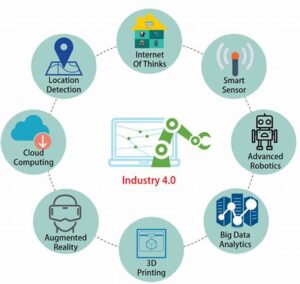In the rapidly evolving world of industrial automation, artificial intelligence (AI) and machine learning (ML) have become transformative forces. These cutting-edge technologies are reshaping manufacturing processes, optimizing operations, and driving efficiency like never before. From predictive maintenance to autonomous systems, AI and ML are pushing the boundaries of what’s possible in industrial automation. In this blog, we’ll explore the profound impact AI and ML are having on the industrial sector and how these innovations are revolutionizing the way industries operate.
Understanding AI and Machine Learning in Industrial Automation
Before diving into the impact of AI and ML, it’s important to understand what these technologies bring to the table.
- Artificial Intelligence (AI) refers to systems designed to simulate human intelligence, enabling machines to perform tasks that typically require human cognition, such as problem-solving, decision-making, and pattern recognition.
- Machine Learning (ML), a subset of AI, is the ability of machines to learn from data and improve their performance without explicit programming. By analyzing large datasets, ML algorithms can identify patterns, make predictions, and optimize processes based on real-time information.
When combined, AI and ML provide an intelligent layer of decision-making and optimization for industrial systems, creating a more adaptable, efficient, and predictive environment.
Key Impacts of AI and Machine Learning on Industrial Automation

1. Predictive Maintenance
One of the most significant contributions of AI and ML to industrial automation is predictive maintenance. Traditionally, maintenance in industrial environments was reactive or scheduled, leading to unplanned downtime or unnecessary repairs. With AI and ML, systems can now analyze historical data, sensor readings, and performance metrics to predict when equipment is likely to fail.
By detecting early signs of wear and tear, machines can be serviced before a breakdown occurs, minimizing downtime and reducing maintenance costs. Predictive maintenance not only increases the longevity of machines but also optimizes resource allocation and boosts overall productivity.
2. Optimizing Production Efficiency
AI and ML enable real-time process optimization, which is critical in today’s fast-paced manufacturing environments. By analyzing data from various stages of production, AI systems can automatically adjust parameters to maximize throughput, reduce waste, and improve the quality of finished products.
For example, machine learning algorithms can analyze the performance of different production lines and make recommendations for adjustments to improve speed and reduce defects. This leads to greater consistency and efficiency in production while minimizing energy consumption and resource wastage.
3. Quality Control and Inspection
In industries such as automotive, electronics, and pharmaceuticals, quality control is paramount. Traditional inspection processes, often reliant on human operators, can be slow, inconsistent, and prone to errors. AI-powered computer vision systems, however, are transforming quality control by enabling faster and more accurate inspections.
Machine learning algorithms can be trained to identify defects in products, detect anomalies, and ensure that only items meeting stringent quality standards make it to the next stage. These systems not only enhance accuracy but also reduce human error, improving the overall quality of the final product and minimizing the risk of defective goods reaching customers.
4. Autonomous Systems and Robotics
AI and ML are playing a crucial role in the advancement of autonomous systems and robotics in industrial settings. Robotic systems equipped with AI and ML capabilities can perform complex tasks such as assembly, material handling, and packaging with minimal human intervention. These robots are able to adapt to changes in their environment, learn new tasks through experience, and make real-time decisions, making them ideal for dynamic manufacturing processes.
Collaborative robots (cobots), in particular, work alongside human operators to enhance productivity and safety. AI enables cobots to interact seamlessly with humans and other machines, optimizing workflows and reducing the risk of accidents or inefficiencies.
5. Supply Chain Optimization
AI and ML are transforming supply chain management by providing real-time insights into inventory, demand forecasts, and logistics. By analyzing vast amounts of data, these technologies can predict supply chain disruptions, suggest optimal inventory levels, and recommend cost-effective routes for shipping and delivery.
This enhanced visibility and decision-making capability improve lead times, reduce stockouts, and minimize inventory costs. AI-powered systems can even predict demand fluctuations, allowing businesses to adjust production schedules and inventory levels proactively, ensuring that they meet customer needs while minimizing excess stock.
6. Energy Efficiency and Sustainability
In an era where sustainability is a major concern, AI and ML are helping industries optimize their energy usage and reduce their environmental impact. By monitoring energy consumption across various production processes, AI systems can identify inefficiencies and suggest adjustments to reduce waste.
Additionally, AI can help with the optimization of energy-intensive processes, ensuring that energy is used more effectively. For example, AI-driven systems can dynamically control heating, ventilation, air conditioning (HVAC) systems, lighting, and equipment operation to minimize energy consumption while maintaining optimal performance.
7. Human-Machine Interaction (HMI)
AI-powered Human-Machine Interfaces (HMIs) are making it easier for operators to interact with complex industrial automation systems. These interfaces leverage machine learning algorithms to personalize and optimize the user experience, offering real-time data visualization, predictive analytics, and decision-making support.
Advanced HMIs can also incorporate voice recognition, gesture control, and augmented reality (AR) to enhance the interaction between operators and machines. As a result, operators can access valuable insights, adjust system parameters, and troubleshoot issues with greater ease, improving the overall efficiency of operations.
The Future of AI and Machine Learning in Industrial Automation

As AI and machine learning technologies continue to evolve, their impact on industrial automation will only deepen. Some key trends to watch in the future include:
- Edge computing will enable AI and ML to process data closer to the source, reducing latency and enhancing real-time decision-making.
- 5G networks will provide the bandwidth needed to connect and manage vast numbers of industrial IoT devices, further empowering AI-driven automation systems.
- Advanced robotics will become more versatile and capable of performing even more complex tasks, working in harmony with humans to increase productivity and safety.
- AI-driven supply chain management will become increasingly autonomous, optimizing every aspect of procurement, logistics, and production in real-time.
Conclusion
AI and machine learning are no longer just buzzwords; they are integral to the future of industrial automation. By enhancing predictive maintenance, optimizing production efficiency, enabling quality control, and improving supply chain management, these technologies are helping businesses stay competitive in a rapidly changing market.
As AI and ML continue to evolve, their impact on industrial automation will only grow, making operations smarter, more efficient, and more sustainable. Manufacturers that embrace these innovations will be well-positioned to thrive in the future of industrial automation, driving progress, profitability, and sustainability across industries.















